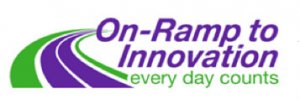In this Issue:
From the Director
The New Jersey Local Technical Assistance Program appreciates your readership and we look forward to continuing partnering with you in 2018. Please remember that several deadlines are approaching- the New Jersey Department of Transportation’s deadline for new research ideas to help inform the next round of research RFPs is December 31, 2017 and the Federal Highway Administration’s Every Day Counts Round 5 solicitation for ideas will end on January 18, 2018.
NJLTAP workshops will start up right after the New Year with work zone safety, construction inspection, and curb ramp design training. We will also be going through the strategic planning process in 2018, where we will be incorporating your feedback from our recent customer needs surveys.
NJDOT Deadline for New Research Ideas to Help Inform the Next Round of Research RFPs is December 31, 2017
The next round of research ideas that may evolve into requests for proposals will be closing December 31, 2017. Research ideas will be prioritized by the NJDOT Research Oversight Committee after the submissions are received. Research ideas may be submitted by NJDOT research customers and other interested transportation practitioners. Ideas will require a “champion”, someone who is holding a responsible position within a unit of NJDOT, who is prepared to sponsor or advance a research idea from its inception to study completion.
To register to submit ideas or vote on other ideas to show support, please visit https://njdottechtransfer.ideascale.com If you have questions regarding registering, please email ideas@njdottechtransfer.net.
Roundabouts Coming Full Circle
The occasion passed this year without note–most people being unaware–and probably the dozens of high-profile stories about infrastructure funding and autonomous vehicles would have eclipsed the event anyway. Despite the lack of fanfare, however, roundabouts in the United States recently experienced a twentieth anniversary, more or less.
Although there is no exact date to pinpoint, national efforts to establish modern roundabouts as an accepted intersection design can be traced back about 20 years. As documented in the National Cooperative Highway Research Program (NCHRP) Synthesis 488 Roundabout Practices, over the course of the past two decades or more, roundabouts have grown from a few sprinkled around the United States to several thousand–with at least one in every State, and some with hundreds.
Experts in the field estimate that the United States now has nearly 4,500 modern roundabouts, meaning the number has nearly doubled over the past 10 years. Compared to countries such as France or the United Kingdom, on the basis of roundabouts to population rate, the United States is still lagging.
Nevertheless, several recently achieved milestones bode well for closing the gap with the Nation’s international peers. In 2016, Carmel, IN, constructed the city’s 100th roundabout. The Wisconsin Department of Transportation finished constructing the first pair of roundabouts with three lanes circulating at the U.S. 41 and WIS 29 interchange in Green Bay and a total of 40 roundabouts along the U.S. 41 corridor in the State’s northeastern region. And in 2017, Yosemite National Park in California and Arches National Park in Utah are constructing the third and fourth roundabouts, respectively, within the National Park Service’s roadway network.
 Where a State or local agency introduces roundabouts for the first time, regardless of motivation, controversy is almost sure to follow. After all, even if roundabouts are familiar to the intersection designer or traffic engineer, they may still be new in a given community. That they are circular instead of orthogonal (right-angle), and rely on yielding instead of binary stop-and-go traffic signals or stop signs, tends to make people feel uneasy at first. Another frequent concern that people express when discussing roundabouts is how to choose the right exit to reach their destination.
Where a State or local agency introduces roundabouts for the first time, regardless of motivation, controversy is almost sure to follow. After all, even if roundabouts are familiar to the intersection designer or traffic engineer, they may still be new in a given community. That they are circular instead of orthogonal (right-angle), and rely on yielding instead of binary stop-and-go traffic signals or stop signs, tends to make people feel uneasy at first. Another frequent concern that people express when discussing roundabouts is how to choose the right exit to reach their destination.
An agency proposing roundabouts in a community for the first time must be prepared to address these anxieties and other concerns. A number of strategies are available, beyond the typical informational meeting on a project. FHWA documented several approaches in a series of case studies known as the “Roundabouts Outreach and Education Toolbox.” The overarching lesson from these case studies is that a proactive and persistent approach is often successful, as seen in the cases below.
Read more stories and case studies about state and local agencies dealt with these issues in FHWA’s Public Roads Magazine!
Sign up for electronic Updates to the MUTCD!
Now from FHWA, you can e-Subscribe for MUTCD-related updates! We’ll send you a notification whenever there’s something new posted to the MUTCD’s What’s New page. Staying connected is now easier than ever!
-
-
- Just go to the MUTCD website.
-
- Look for the eSubscribe envelope near the upper left corner.
-
- Enter the e-mail address at which you would like to receive notifications.
-
- Enter your preferences.
-
That’s it—you’re signed up! You can change your preferences or unsubscribe at any time. And be sure to tell a friend or colleague!
Can Self-Driving Equipment Make a Work Zone Safer?
Warning signs, barriers and other countermeasures can reduce some of the risks workers face in highway work zones, but they don’t totally eliminate the hazards. Working with and around heavy highway equipment is never completely free of danger. Neither is constantly being in close proximity to traffic, where drivers may be angry, tired, distracted or under the influence.
 On average, 121 workers at road construction sites are killed on the job every year and more than 20,000 are injured. The majority of these fatalities and injuries occur when workers are struck by backing construction equipment or when motorists drive into the work zone. To reduce these risks, many contractors use impact protection vehicles equipped with truck-mounted attenuators (TMAs).
On average, 121 workers at road construction sites are killed on the job every year and more than 20,000 are injured. The majority of these fatalities and injuries occur when workers are struck by backing construction equipment or when motorists drive into the work zone. To reduce these risks, many contractors use impact protection vehicles equipped with truck-mounted attenuators (TMAs).
“These vehicles follow road crews and create a physical barrier between workers and the public that can save a life in the event of a work zone intrusion,” says LIUNA General President Terry O’Sullivan. “Remotely operated equipment protecting the work zone could potentially eliminate deadly work zone intrusions and that is a positive step for work zone safety.”
TMAs are designed to be hit, which makes driving them a potentially dangerous job. In Colorado alone, there have been 26 incidents of motorists crashing into TMAs over the last four years. These vehicles are usually unoccupied when protecting a stationary work site, but projects such as paving often involve workers following alongside as the job progresses. That’s why this past summer, the Colorado Department of Transportation (CDOT) began using a remote-controlled impact protection vehicle operated by a driver in another truck traveling ahead of it. If the wireless connection is lost, the driverless vehicle automatically comes to a stop. If the vehicle with the TMA is hit, there’s nobody sitting in the cab that can be injured.
Read more, and check out a video showing how this technology works at Laborers’ Health and Safety Fund of North America’s webpage! system.
AASHTO Materials Standards Update
AASHTO recently released the third of three 2017 updates to the Standard Specifications for Transportation Materials and Methods of Sampling and Testing, and the AASHTO Provisional Standards, 2017 Edition (the Materials Standards).
This update includes 8 new and 23 revised standards, and updates the sections on Geotechnical, and Bituminous Materials and Mixtures. Those with a current subscription to the web-based Materials Standards will automatically receive the updated information.
For more information about the features of the web-based format of the Materials Standards, check out this informational video below. To purchase a subscription, click here to link to the publication on the AASHTO Bookstore.
NHI Offers Speed Management Training
Speeding is a factor in almost one-third of all fatal car crashes in the United States. More than 112,500 people died in speeding-related US highway crashes from 2005-2014. This is roughly equal to the number who died in alcohol-involved crashes over the same period; however, speeding gets far less attention.
Findings from a recent study by the National Transportation Safety Board, Reducing Speeding-Related Crashes Involving Passenger Vehicles, indicate that substantial reductions in highway crashes cannot be achieved without a renewed emphasis among safety partners on reducing speeding.
FHWA agrees and considers speed management to be a key safety program for FHWA, which has identified improvements in three safety focus areas—roadway departures, intersections, and pedestrians and bicyclists—as having strong potential to reduce speeding-related fatalities.
Because speeding is impacted by a variety of cross-cutting factors, preventive safety measures should be addressed by State and local governments in a comprehensive speed management program. To support governmental agencies in creating speed management programs, the training and education arm of FHWA, the National Highway Institute (NHI), has released a new Speed Management training course. The course is a one-day, in-person event led by an NHI-certified instructor. In it, participants learn about life-saving countermeasures to shape speed management programs and how these programs can help communities reduce speeding-related injuries and deaths.
The training also explains the negative impact of speeding on community safety and describes how State and local governments can improve safety and reduce fatalities by specifically focusing on effective countermeasures for reducing speeding-related intersection, roadway departure, and pedestrian and bicycle crashes. Participants who complete this training will be able to appropriately apply safety strategies and countermeasures to reduce speeding-related traffic fatalities as part of a comprehensive speed management program.
The course is ideal for transportation professionals from every level of government, as well as law enforcement and other public safety advocates who are interested in having safer roadways through the application of speed management principles. To learn more, visit the NHI website and search for “Speed Management 380116.”
Call for EDC-5 Innovations Open
The Federal Highway Administration is seeking information from State, local, and industry partners and the public on proven processes or technologies that have the potential to provide efficiencies. Specifically, the FHWA is interested in innovations and in processes, which have the potential to transform the way the highway transportation community does business by enhancing roadway safety, shortening project delivery time, reducing traffic congestion, and/or improving environmental sustainability. The information may assist FHWA identify proven, market-ready innovations for potential deployment through the fifth round of EDC (EDC-5) in 2019-2020. The EDC program has made a significant positive impact in accelerating the deployment of innovations and in building a culture of innovation within the highway community. Since the inception of EDC, each state has used 14 or more of the 43 innovations promoted through Every Day Counts, and some states have adopted more than 30.
 Many of these innovations have become mainstream practices across the country. By advancing 21st century solutions, the highway community is making every day count to ensure our roads and bridges are built better, faster, and smarter. Responses should be submitted by electronic mail to EDC-5suggestions@dot.gov by January 18, 2018. For ease of submittal, this pdf form may be used.
Many of these innovations have become mainstream practices across the country. By advancing 21st century solutions, the highway community is making every day count to ensure our roads and bridges are built better, faster, and smarter. Responses should be submitted by electronic mail to EDC-5suggestions@dot.gov by January 18, 2018. For ease of submittal, this pdf form may be used.
Colorado DOT Tests Self-Driving Work Zone Vehicle
The Colorado DOT has unveiled a first-of-its-kind work zone vehicle designed to keep roadway maintenance crews safe. Typically crash cushion trucks are positioned behind construction crews in order to protect workers from vehicles moving around work zones. Now, CDOT has unveiled an Autonomous Impact Protection Vehicle (AIPV) that takes the driver out of the vehicle.
Since the purpose of the crash cushion trucks is to absorb the damage of crashes in the first place, it only makes sense to remove the driver from this vehicle. The AIPV is linked to another human-driven vehicle and follows it precisely with GPS technology.
OSHA Webpage Redesign
Employers and employees can get information on job safety classes, trainers, tools, and 10-hour and 30-hour cards more easily using OSHA’s redesigned training webpage. The page offers links to resources on training requirements and resources, outreach training, OSHA Training Institute Education Centers, and Susan Harwood Training Grants.
Be Prepared for Winter Weather
As outdoor temperatures drop and winter storms approach, employers should take measures to keep their employees safe. OSHA’s Winter Weather webpage provides information on protecting employees from hazards while working outside during severe cold and snow storms. This guidance includes information on staying safe while clearing heavy snow from walkways and rooftops.
TIM Program Reaches New Milestone
U.S. Transportation Secretary Elaine L. Chao joined officials representing the Washington Metropolitan area’s first responders to announce today that the 300,000th emergency responder has completed the Federal Highway Administration’s “Traffic Incident Management” (TIM) responder training, a national effort to improve the safety of first responders on the scene of highway crashes.
“The courage and dedication of America’s emergency responders is inspiring as well as life-saving,” said Secretary Chao. “Traffic Incident Management training helps save the lives of first responders, who put their own safety at risk every day when they go to work and respond to our nation’s highway crashes.”
The event, during National Traffic Incident Response Awareness Week (NTIRAW), highlighted the commitment of the first responders who keep our nation’s highways safe. To assist their efforts and to ensure their safety, FHWA developed the TIM responder training course. Designed by and for responders, the course helps build teams of well-trained police, firefighters, highway workers, and emergency medical and towing personnel. Together, they learn a common set of practices, including quick clearance techniques that improve communications and reduce the amount of time needed to remain on scene. The training will remain available along with a refresher course.
The 300,000 emergency responders who have completed the training represent all 50 states, the District of Columbia and Puerto Rico.
Secretary Chao signed a proclamation in honor of NTIRAW and as a declaration of the Department’s commitment to the safety of the nation’s first responders.



